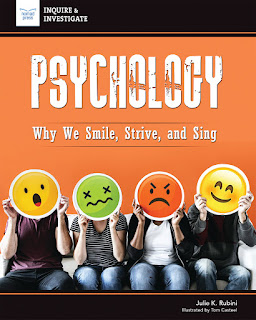Welcome to Julie Rubini, whose dedication to children's literacy is well recognized across Ohio! Julie's new book is all about the teenage brain.....
My latest
book, Psychology: Why We Smile, Strive and Sing explores the WHY behind
behavior and choices, written for teens. How cool is that?
I wish I
had a book like this when I was a teenager. It would have helped me understand
all the different factors involved in choices, including my home environment,
genetic history, friends, peer pressure, and, the area I found most
fascinating, the teenage brain.
Scientists
are doing some amazing work in studying the teenage brain, including the
exciting functional MRI testing. The test involves recording what happens, or
doesn’t happen in a teenager’s brain, based on various stimuli. For example,
while a subject’s brain is being studied using functional MRI testing,
scientists may show the subject scary photographs, to see how the amygdala, the
part of the brain that perceives and regulates fear, responds. Or, scientists
will record how teens’ prefrontal cortexes respond to simulated situations when
the teenage subjects believe they are being watched. The prefrontal cortex is
the area of the brain that involves reasoning and making judgments and
decisions.
These
studies help us understand the role the development of the brain has in teen
behavior. But that is only one part of the equation.
Why does
one teen, perhaps feeling anxious about a test, stay up all night and study,
while another stays up all night playing video games? Why does one teen stand
up to a bully picking on a friend, while another walks away? Why has one teen
explored new talents during Covid-19 shelter at home restrictions, while
another rages at the inability to do anything?
Psychology:
Why We Smile, Strive and Sing
explores the topic of psychology for teens, and reviews all of the various
elements involved in reactions, behavior, and choices to help them understand why
they do the things they do.
Experiment:
As peer
pressure is significant in the lives of teens, the following experiment studies
conformity, the influence of groups. The Asch Conformity Tests proved that, on
average, a third of a group would answer a question incorrectly, based on the
influence of others, even when they knew otherwise.
Try this
test to see if results compare with the Asch Conformity Tests.
Recruit a
few friends to stand in a shopping mall. They should just stand and look at the
ceiling.
Make a
simple grid in a notebook and record how many people stop and stare with the
group within 15 minutes. How many pass by without participating in the
behavior? Record these results and compare your study to the Asch Conformity
Tests. Did a third of the people walking past in the mall look up to the
ceiling as well?
 Julie K.
Rubini loves to writing stories about incredible women and intriguing subjects
for young readers. Julie’s newest work is Psychology: Why We Smile, Strive
and Sing, helping teenagers understand the science behind their behavior.
Julie’s other works include, Eye to Eye:
Sports Journalist Christine Brennan, Missing
Millie Benson: The Secret Case of the Nancy Drew Ghostwriter and Journalist,
and Virginia Hamilton: America’s
Storyteller, which received a Kirkus starred review and listed on Bank
Street College of Education’s Best Children’s Books, outstanding merit.
Julie K.
Rubini loves to writing stories about incredible women and intriguing subjects
for young readers. Julie’s newest work is Psychology: Why We Smile, Strive
and Sing, helping teenagers understand the science behind their behavior.
Julie’s other works include, Eye to Eye:
Sports Journalist Christine Brennan, Missing
Millie Benson: The Secret Case of the Nancy Drew Ghostwriter and Journalist,
and Virginia Hamilton: America’s
Storyteller, which received a Kirkus starred review and listed on Bank
Street College of Education’s Best Children’s Books, outstanding merit.
Julie and
her husband Brad established Claire’s Day, a children’s book festival in honor
of their daughter. A highlight of the festival is the C.A.R.E. Awards, given to
children selected as the most improved readers in their schools.
Visit www.julierubini.com or www.clairesday.org to learn more!

No comments:
Post a Comment